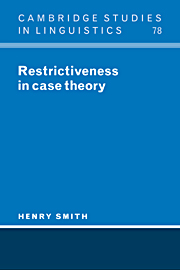1 - Introduction
Published online by Cambridge University Press: 04 November 2009
Summary
Preliminaries
The study of case has many facets, and the word “case” itself has come to mean many things. This study aims at a better understanding of the way case functions in syntax by providing a new theory of the syntactic functioning of case and other morphosyntactic devices.
Because the focus is on case as it functions in syntax rather than case as a morphological category, I will make certain assumptions which will figure prominently below. First, I will assume that morphological case and syntactic case do not always coincide. Morphological case will simply be the paradigms of affixes which may carry other information as well, e.g. gender and number. For example, the “dative” case as a morphological category is a set of endings. My primary concern is with syntactic case, and here the distinctions are not quite so visible. A syntactic case will be defined by its basic distribution and its interaction with other cases. For instance, if we observe that dative marks the goals of various verbs – what might be termed “indirect objects” – we have a situation very common in the world's languages: I(nom) gave you(dat) the book (acc). But quite often we then notice that the dative marks an NP that is an experiencer in a sentence based on a two-place predicate: I(dat) like the book (nom). At this point we have a choice. We can assert that the “ I ” NP in such a sentence is the “same” in some sense as the “you (dat)” in the sentence with the three-place predicate. The “sameness” might be identity of “grammatical relation,” for example indirect object (or 3 in Relational Grammar).
- Type
- Chapter
- Information
- Restrictiveness in Case Theory , pp. 1 - 21Publisher: Cambridge University PressPrint publication year: 1996



